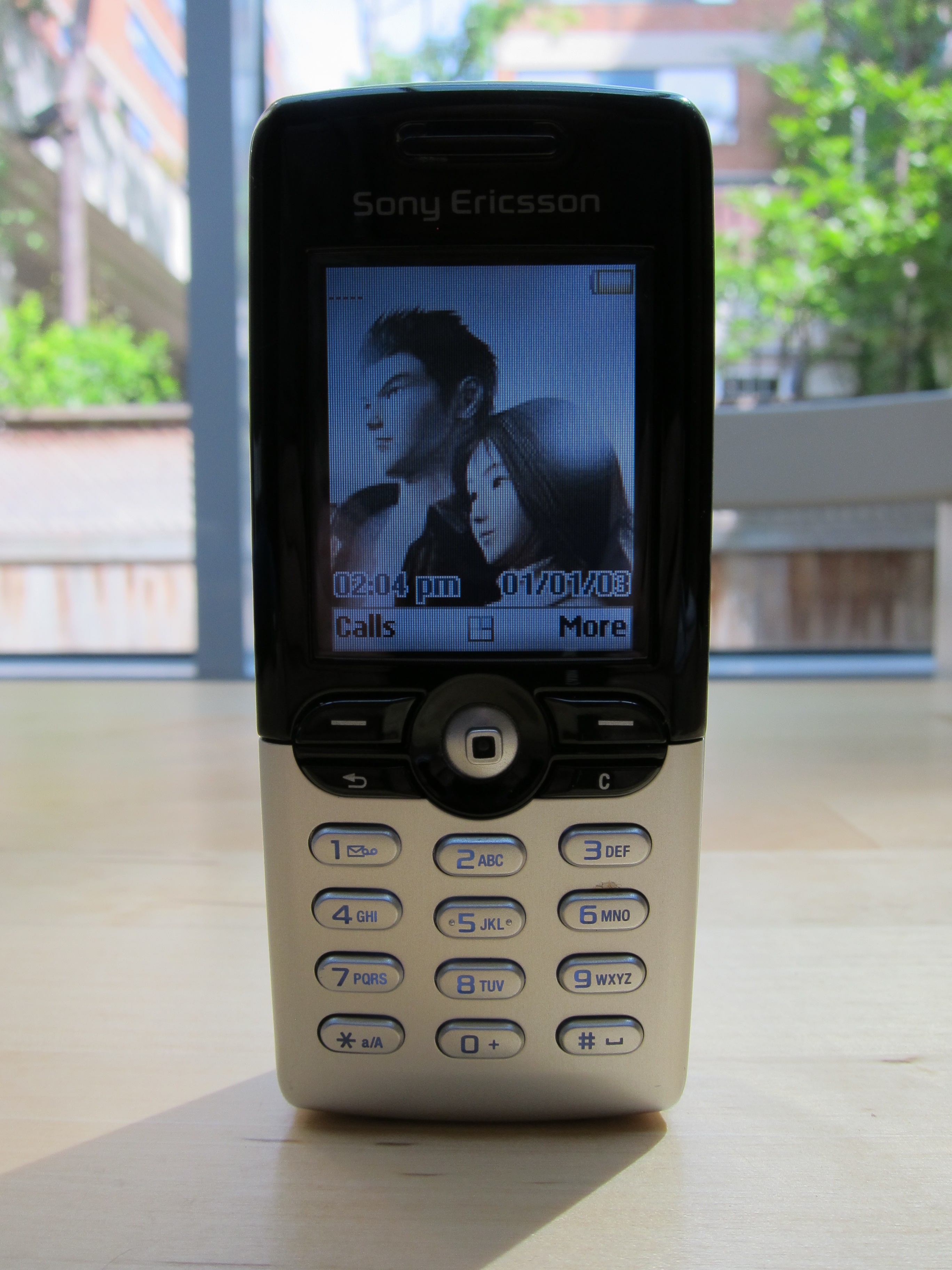And yet I used this “dumbphone” (along with two other nearly identical models) for over a year, thanks largely to a technological standard called SyncML.
If you didn’t know, SyncML stands for Synchronization Markup Language. It allows one’s personal data — calendars, contacts, to-do items and more — to be synchronized between phone and desktop computer. Now here’s the important part: Unlike Palm’s proprietary HotSync, SyncML is an open standard, so anyone can make software for it. By this time Apple’s OS X desktop had SyncML support through an app called iSync; while my T616 wasn’t fully supported from the get-go, a third-party program called PhoneAgent did everything that iSync didn’t.
I didn’t even need a data cable; Bluetooth finally proved its worth as a means to wirelessly synchronize my data and install files to my handset. And thanks to Sony Ericsson’s sizable fanbase in Asia and Europe I was able to trick out my T616 with all manner of custom ringtones and themes.
All of the above actually applies to three separate handsets — the T616, T610 and Z600. The two “Ts” were virtually indistinguishable from the outside; on the inside, the T610 had a radio with an extra European band (900MHz) while the T616 swapped that out for an extra North American band (850MHz). This was more or less irrelevant, as both handsets worked on both continents, and Fido didn’t support the 850MHz band at the time.
The Z600 shared the same camera and internals, but was a bigger flip phone with customizable front and back panels.
It’s hard to say which one I liked more; the Z600 felt like a Japanese keitai but clearly needed a protective case, while the T610 and T616 were small enough to fit into the lighter pocket of my jeans. Of course I ended up dropping two out of the three, each in a different exotic locale. I managed to dent the metal case of my T616 by sending it crashing to the hard wooden floor of a swanky Bermuda hotel, and did about as much damage to the plastic housing of my Z600 as I fumbled with it in a public washroom atop Table Mountain in Cape Town, South Africa.
I also remember these handsets for their goofy accessories. I bought a Bluetooth-controlled toy car for my T610 that my cat chased for all of thirty seconds, then never again. For the Z600 I got a snap-on game controller, which was far too ridiculous-looking to ever use in public. I still have both of them tucked away in a drawer somewhere.
Any takers?
]]>
I believe the expression “Sony guts” would apply here. Though very different on the outside, Sony Ericsson’s T610 and T616 candy bar phones share the same specs with the Z600 flip. And really, the only thing separating the T610 and T616 is the 900Mhz compatible radio in the former, and 850MHz support for the latter.
I personally owned all three. I sold my T616 but never found another home for my T610, shown above. And who’s that dashing young man I’ve got in my wallpaper? Here’s a hint.
I didn’t just trick out my T610 with wallpapers, ringtones and games… I also bought this tricked-out Bluetooth-controlled car. You could drive it via the joystick on your phone, barely. And what really sucked was that the car would only take a charge from the phone, sucking up precious battery.
Back to the phone, you can read Steve Punter’s February, 2004 review of the Fido-branded T616 here.
The strip of photos above (via this Korean blog) pretty much shows you that the Z600 was all about the changeable covers. I’ve still got a couple in my drawer, along with that game controller.
You can see MobileBurn’s gallery of the controller (and car) here, and their review of the Z600 here.
If you were wondering how photos were from either camera, well… they were exactly like this.
]]>One of the biggest reasons why I didn’t keep it was the price tag: nine hundred and fifty Canadian dollars was a bit too dear. I think it was my Treo that instilled in me the optimal price point for one of these high-functioning handsets; even today, I’m loathe to pay more than five hundred bucks for one. And Fido offered no subsidies for the P800, as it was very much a niche device.
I might have given the P800 more consideration had it a proper qwerty keypad. Using the number pad for anything other than entering phone numbers was decidedly unpleasant. The touchscreen underneath had built-in handwriting recognition that didn’t work at all for me — I would have much preferred something more familiar, like Palm’s Graffiti alphabet. Instead, I had to make do poking at an on-screen keyboard with the included snap-on stylus. Not fun.
But the biggest problem with Sony Ericsson’s smartphone was that it had no available options for syncing data to my Macintosh computer. Remember that I’ve only ever wanted two things from my mobile phone, and above all else the ability to share a single address book. Apple to this day is still dwarfed by Microsoft Windows in terms of market share, and I wasn’t about to buy a new computer just for a phone (at least not yet). To manually write phone numbers to my SIM card would be an instant regression back to the stone age, and an immediate deal-breaker.
One thing the P800 had going for it was an integrated VGA camera. I decided that my next mobile would also be a camera phone. And sure enough, it was.
]]>
Here’s Sony Ericsson’s first smartphone, the P800 — which I trialled for about a week in June, 2003. A gallery of photos taken with the VGA camera ’round back was one of the last things I posted on my first-ever blog. These two press photos were pooched from PDAStreet.
Note that the number pad was on a hinged panel that could be folded down or taken off completely, revealing a touch-screen underneath. The phone was powered by UIQ, Sony Ericsson’s fork of the Symbian mobile operating system. Years later I would come to appreciate the power of Symbian and S60, but back then I remember a distinct lack of sync options for Macintosh computers. Also, this beast of a phone had a price tag to match.
Here’s Steve Punter’s review of the P800 from December, 2003.
]]>Sony had already been making their own handsets — at least in the UK — for quite some time. Their join venture with Ericsson was inked in 2001 but the T68i, the combined companies’ first product, took almost two years to arrive in Canada. Its standout feature was an available camera accessory that plugged in to the bottom of the phone.
It was an expensive add-on that I never even bothered with; in fact, this particular phone/PDA combo lasted maybe a week before I sent both back to their respective stores. In theory, using a phone as a Bluetooth modem was a godsend. One could enjoy the mobile Internet on an expansive touch-enabled screen while the signal source was safely tucked away in a pocket. In practice, though, this setup was a pain. A constant Bluetooth connection easily halved the battery life of both devices; your only other choice was to pair and un-pair them manually throughout the day.
I vowed that I would never again separate PDA from phone, and my next device kept me to that promise…
]]>
Here’s the best photo I could find of Sony Ericsson’s first handset, the T68i — via this Chinese image site.
This particular phone is legendary enough to merit a rather substantial Wikipedia entry. I already knew that this refreshed Ericsson T68 was the first product of the Sony-Ericsson partnership, but here’s something I didn’t know:
The T68i was the first Ericsson (Sony) free from brominated flame retardants (BFRs).
Take that, brominated flame retardants (BFRs)…
You can check the specs on GSM Arena here and read Steve Punter’s review from December, 2001 here. Oh, and apparently MobleBurn was publishing reviews back then too!
Note that I only had this phone for about a week in May of 2003, so my chapter about it may end up being as brief as this database entry.
]]>


